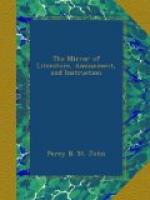[Illustration: Mount Ararat, from a drawing, by Sir Robert Ker Porter.]
Perhaps the most recent visit to this wonder of the East will be found described in Mr. J.H. Stocqueler’s Journal of Fifteen Months’ Pilgrimage through untrodden Tracts of Khuzistan and Persia, in 1831 and 1832:—
“We mounted our horses,” says the enthusiastic traveller, “soon after sunrise, and had proceeded for about four hours over numerous acclivities, and through a territory of undulations resembling the waves of the sea deprived of motion, when the southern peak of Ararat (for there are two), snow-clad and ‘cloud-clapt’ suddenly burst upon my view! At first I scarcely dared venture to believe we were so near this celebrated mount, though its situation and the distance we had journeyed from Tabreez left no doubt of the fact. I even questioned the guide, and on his answering that it was the summit of Agri-Dagh (the name by which Ararat is called by the Turks), I involuntarily clasped my hands in ecstacy! Who can contemplate this superb elevation without a mixture of awe and admiration, or fail to recur to the page of sacred writ illustrative of Almighty wrath and the just man’s recompense? Who can gaze upon the majesty of this mount, towering above the ‘high places’ and the hills, and turn without repining to the plains beneath, where puny man has pitched his tent and wars upon his fellow, mocking the sublimity of Nature with his paltry tyranny? I felt as if I lived in other times, and my eye eagerly but vainly sought for some traces of that ‘ark’ which furnished a refuge and a shelter to the creatures of God’s mercy when the ’waters prevailed, and were increased greatly on the earth,’ till ’all in whose nostrils was the breath of life, and all that was in the dry land, died!’
“Though distant forty miles at least from the base of Ararat, the magnitude of the mountain, of about the centre of which our elevated position now placed us abreast, caused it to appear contiguous to our route, and produced that indefinable thrill and sense of humility which the immediate presence of any vast and overpowering object is so eminently calculated to generate. I continued to gaze until the decline of day warned us to seek a shelter, and Phoebus, casting a parting glance at the crystal summit of the noble glacier, for a moment diffused over all a soft rosy tint,[20] then sunk into the west and left the world in darkness.”
[20] This peculiar effect of the
setting sun on snow-covered
mountains has been observed by other travellers
in other
regions. In Switzerland the phenomenon
is by no means
rare.
“And sun-set into rose hues sees them wrought.”
Byron.
* * * * *
NUTRIA FUR.
(To the Editor.)




